AMD A10-5800K & A8-5600K Review: Trinity on the Desktop, Part 2
by Anand Lal Shimpi on October 2, 2012 1:45 AM ESTContent Creation Performance
Adobe Photoshop CS4
To measure performance under Photoshop CS4 we turn to the Retouch Artists’ Speed Test. The test does basic photo editing; there are a couple of color space conversions, many layer creations, color curve adjustment, image and canvas size adjustment, unsharp mask, and finally a gaussian blur performed on the entire image.
The whole process is timed and thanks to the use of Intel's X25-M SSD as our test bed hard drive, performance is far more predictable than back when we used to test on mechanical disks.
Time is reported in seconds and the lower numbers mean better performance. The test is multithreaded and can hit all four cores in a quad-core machine.
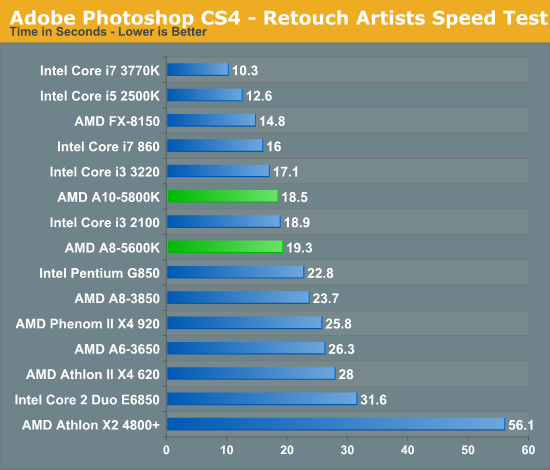
Our Photoshop workload still runs better on Intel hardware, but the gap in performance between the 5800K and 3220 is smaller than it was between the FX-8150 and 2500K last year. While Bulldozer was pretty much unrecommendable, Trinity approaches tradeoff territory.
3dsmax 9 & POV-ray
Today's desktop processors are more than fast enough to do professional level 3D rendering at home. To look at performance under 3dsmax we ran the SPECapc 3dsmax 8 benchmark (only the CPU rendering tests) under 3dsmax 9 SP1. The results reported are the rendering composite scores.
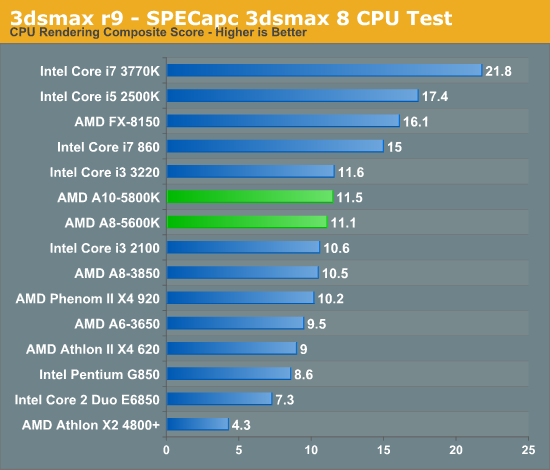
Once again in a heavily threaded FP benchmark, the A10 and Core i3 perform very similarly. POV-Ray is another example of this below:
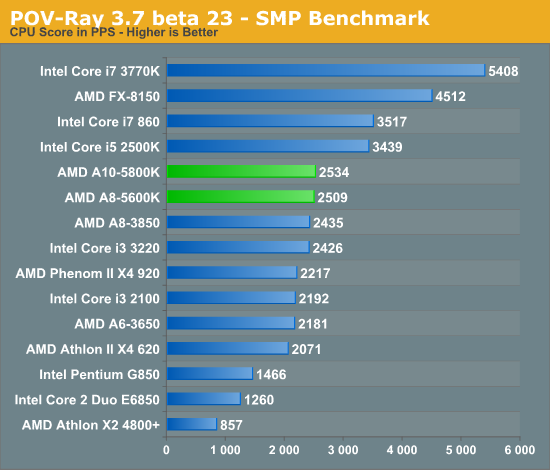
File Compression/Decompression Performance
Par2 is an application used for reconstructing downloaded archives. It can generate parity data from a given archive and later use it to recover the archive
Chuchusoft took the source code of par2cmdline 0.4 and parallelized it using Intel’s Threading Building Blocks 2.1. The result is a version of par2cmdline that can spawn multiple threads to repair par2 archives. For this test we took a 708MB archive, corrupted nearly 60MB of it, and used the multithreaded par2cmdline to recover it. The scores reported are the repair and recover time in seconds.
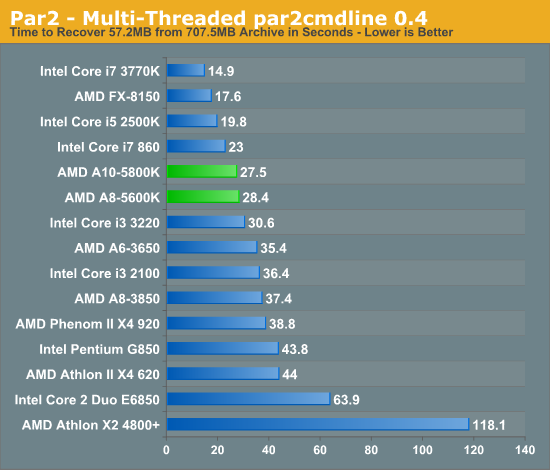
Our multithreaded Par2 recovery test shows AMD with a small advantage over the Core i3 3220, although it obviously can't touch any of the more expensive quad-core parts.
Excel Math Performance
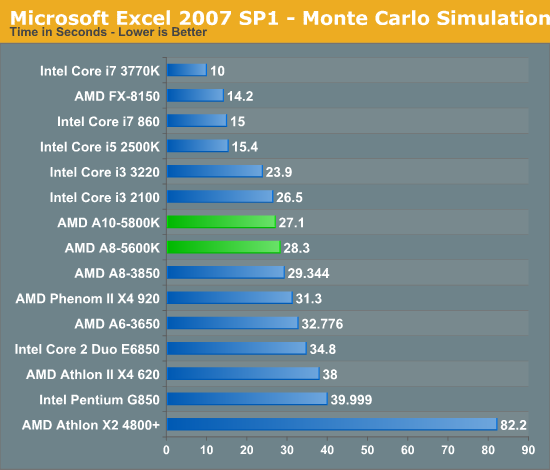
Not all heavily threaded FP applications are easy wins for AMD. In our Monte Carlo simulation benchmark the 3220 manages a decent lead over the A10-5800K.
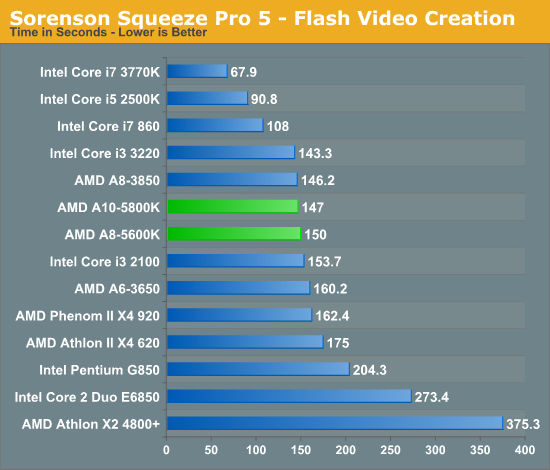
Our old Sorenson Squeeze test is one area where we see a slight regression compared to Llano. Like I mentioned earlier, this isn't super common but it does happen from time to time given the dramatic architecture difference between Llano and Trinity.










178 Comments
View All Comments
wenbo - Tuesday, October 2, 2012 - link
I think for real enthusiasts building a gaming PC is going to cost 750 to 850 dollars + what ever display you buy. AMD's FX-8150 seems to be really good. it's currently sold for 189 dollars less 20 promotion. And the combo is $502.00 + about 200 graphics and 100 SSD + 30 dollar fan give an acceptable gaming PC for less than 850 (with some savings power supply and case give you about $70 off, which means a total of $780) And an equivalent Intel I5, you pay for non-usable HD graphics is going to be about 50 to 70 dollars more expensive (on the processor and motherboard).The difference is on processor is really not that much without much of a promotion on A10-5800K, $169 vs $122. The savings would be on graphics, the best one you can get is HD6670 (I think you can only hybrid crossfire on this), which is $70 after rebate. So the difference is about 180 dollars. and motherboard is cheaper, at 80 dollars, That means you have an entry level gaming PC for a little more than $600 ($607 according to above numbers).
With similar configuration getting a intel i3-2100 is 119.99 at newegg + 129.99 motherboard + 70 graphics + 150ssd + 50 case + 50 power + 55 memory gives you 624.98 ( you don't need a fan, because you CANNOT overclock i3s).
So there is really not much of a difference.
wenbo - Tuesday, October 2, 2012 - link
It would be good to know the price for each of the PC build that was bench marked.owlxp - Tuesday, October 2, 2012 - link
Your math seems a bit off here:i3-2100 set up:
cpu - 120
mobo - 130
gpu - 70
ssd - 150
case - 50
psu - 50
memory - 55
-------------------
total = 625
trinity 5800k set up:
apu - 130
mobo - 60
ssd - 150
case - 50
psu - 50
memory - 55
------------------
total = 495
If we're talking entry level gaming...........I'll take trinity and the extra $130
wenbo - Wednesday, October 3, 2012 - link
I meant if you want trinity, don't you want crossfire? So that is 70 dollars at most. And A10 is unlocked that means overclocking, so you need a bigger fan which is 30 dollars. Motherboard is a bit more than 60 dollars, at least I couldn't find one that cheap.But I bet you are right, as soon as the holiday season motherboard price will drop to 80 - 90 dollars. If you don't care about overclocking, that's another 30, and yes, you can play most games in medium to low settings with respectable framerate without crossfire.
Tech-Curious - Friday, November 2, 2012 - link
Why are you paying $130 for a motherboard to be used in a budget i3 rig? Do you really intend to pair a locked, budget CPU with a z77 chipset? Grab up a B75 for $60-70.I realize that AMD-chipset motherboards have a long-standing reputation for cost-efficiency relative to their Intel counterparts, but the facts just don't conform with that reputation right now.
I'm also not sure why you're paying $55 for memory; I grabbed up a pair of 4GB DDR3 1600 Kingston modules a week or so ago for $30 on Newegg. Granted, that was a sale price, but the same modules are only $40 normally. In fact, if we're to compare apples to apples, the memory subsystem will tend to cost you more on current-gen AMD platforms because the AMD platform wants for higher-speed memory.
(I am, of course, assuming that you're using USA-market pricing. If not, I apologize, but I still don't see why you think it's fair to compare a random AMD bundle deal against your seemingly hat-picked price scheme for a comparable Intel box. There are bundle deals for Intel products too.)
For what it's worth, the build I just ordered about a week ago (mostly from newegg, unfortunately the shipping's been delayed by Hurricane Sandy) consists of the following:
Intel Core i3 3220 - $100 (in-store pickup deal at Microcenter)
ASUS P8B75-M (B75 chipset) - $70
HIS Radeon HD 7850 (1 GB version) - $165
2*4GB Kingston HyperX XMP DDR3 1600 (cas 9) - $30 with discount promo code
Seasonic M12II 520 Bronze power supply - $69
Intel 330 SSD 240GB - $180
Windows 7 x64 Home Premium - $80 with discount promo code
Random cheapo DVD drive - $15
Total - 709
Granted, I didn't buy a case because I already have one. Granted, I found a number of limited-time deals. I also splurged (a lot) more than your average budget builder on the SSD and power supplies. (For me, finally, the extra convenience of the larger SSD was worth going over budget by a fair amount. I'm also a shameless fanboy of Seasonic power supplies, and I like to have a little extra power head room.)
I'm sure more savvy system builders could do more with the money I spent, too. The only reason I'm laying out what I bought is to give people an idea of what can be done if you're willing to hunt around a bit and be patient. You can wring a great deal of performance out of either an AMD or Intel system on a pretty tight budget.
Sorry for the mini novel.
Tech-Curious - Friday, November 2, 2012 - link
Check this out, for a budget Intel bundle, btw:http://www.newegg.com/Product/ComboBundleDetails.a...
Intel Core i3-3220 Dual-Core, Gigabyte GA-B75M-D3V Motherboard, Mushkin DDR3 8GB Memory, Mushkin 120GB SSD, Gigabyte ATX Mid Tower Case, Rosewill 400W PSU SuperCombo
Bob Todd - Tuesday, October 2, 2012 - link
Looking through the narrow lens of A10 vs i3, I would absolutely choose Trinity since it fits my needs better. However, there is no upward scalability and there never will be. With LGA 1155 you could start with a < $50 Sandy Bridge based Celeron G530. You can go from there to any price/performance point up to an i7-3770K for $329. Then there's the enormous LGA 1155 motherboard footprint. Newegg has 254 LGA 1155 motherboards listed right now! That kind of competition has put a lot of downward pressure on pricing.Even for a cheap HTPC build I'm not sure I could justify an FM2 build vs. LGA 1155, the market is just flooded too heavily in Intel's favor giving you so many options to repurpose whatever you build. Trinity just doesn't make sense for me on a desktop. Mobile Trinity where I won't ever upgrade the CPU/GPU...now I've got something to get excited about. In smaller form factors without room for a discrete GPU (somewhere between 10" and 13"), they could have a very competitive product. Give me an X230 successor with Trinity and a 1080p IPS panel and I'll throw money at you.
owlxp - Tuesday, October 2, 2012 - link
Well AMD did promise to keep the FM2 socket for their gen 3 cpus. I think Trinity is good enough to get you to 2014. If the gains in the next gen apu's are anything like what we saw from llano to trinity, that extra $130 I saved in going with the trinity build now, just paid for my upgrade a couple years from now.However, I completely get where you're coming from. I'm struggling with the same problem as I prepare for my next upgrade.
Aone - Tuesday, October 2, 2012 - link
We have been hearing many times from AMD that iGPU inside APU are so powerful that they would kill off cheap dGPU. That what I have expected to see in the review: Pentium+cheap dGPU vs. APU(w/o dGPU).As to cheap prices for APU, we have to keep in mind that 1155 MBs are ~20$ cheaper than FM2 MBs, and APU systems need faster and therefore more expensive RAM than Pentium+d.GPU systems. to get better GPU performance.
mikato - Wednesday, October 3, 2012 - link
It will get there in time. I suggest you check how fast the iGPU performance has grown with AMD's APUs. And they're just getting started. You know they do make high end GPUs and now they've proven they can put their GPUs on die with the CPU, so they will be putting this tech into their APUs.